#particleeffect
Explore tagged Tumblr posts
Text
Analysis of: YouTube video "Découvrez les Coulisses de A Plague Tale Requiem la pépite d'Asobo Studio" by Julien Chièze
youtube
The term "document" in the following text refers to the video's subtitles.
Summary of the key discussions:
Concept art process with over 100 pieces created to inspire 3D art and level design. Iterative refinement shown.
Proprietary game engine development focused on optimizing and evolving between games to enable ambitious designs.
Art, programming, sound design, cinematics, QA testing and simulation techniques showcased.
Sound design emphasized composition, scores, foley, ambient layers and 3D audio support.
Cinematics utilize mocap/performance capture, facial matching for over 2 hours of cutscenes.
Level/environmental art creation inspired by concept art iterations into 3D worlds.
Simulation of up to 3 million rats through particle systems, Houdini and engine optimizations.
QA testing covered gameplay evaluation, bug fixing, developer guidance roles.
Culture appeared dedicated to teamwork, creativity, technical excellence and quality standards.
High production values indicated across disciplines like extensive art, animation, sound and polish.
Transparency shown in detailed explanations of various pipeline aspects and challenges.
Ambition to push technical boundaries and listen to player feedback between entries.
Summary of the document content:
The tour guide provides an introduction and discusses different departments within the studio such as art, programming, sound design, and quality assurance testing.
In the art department, they discuss concept art development and how concept art is used to inspire 3D art and level design. Over 100 pieces of concept art were created.
Programming discussions include using a proprietary game engine, improvements made between games, and optimizations to support increased numbers of simulated rats.
Sound design covers foley recording, ambiance design, music integration, and 3D spatial audio support.
Quality assurance testing encompasses gameplay testing, debugging, providing guidance to developers, and ensuring quality.
Cinematic development is discussed, showcasing motion capture, performance capture, facial animation matching, and integrating over 2 hours of cinematics.
Level design and environmental art creation is demonstrated through multiple concept art iterations and integration into the game world.
Simulation of large numbers of rats (up to 3 million) through particle systems and optimizations is highlighted.
Various workspaces, demonstration areas, and in-development assets are toured.
How concept art is used to inspire 3D art and level design:
The art department creates a large number (over 100 pieces) of concept art to establish the visual style and environments.
Concept art goes through multiple iterative refinements as more details are added.
It is used to inspire the 3D environmental artists and level designers in building out the game world.
Early concept art acts as a skeleton that later art adds more substance and realism to.
Level designers and 3D artists are able to get inspiration and ideas for how to construct levels, environments and assets from the conceptual artwork.
Assets shown changing from early concept artwork to highly detailed 3D versions incorporated into actual game levels.
The concept art process allows the creative vision to be established before full 3D art production and helps guide that production.
So in summary, extensive conceptual artwork forms the basis for the overall art style and acts as a starting point to inspire more realistic 3D art production and level design integration into the actual game.
The proprietary game engine:
The studio uses a custom-built, proprietary game engine to develop their games.
Having their own engine allows for greater flexibility than a third-party engine like Unity.
It enables them to more easily implement ambitious ideas that may be difficult in other engines.
Significant improvements were made to the engine between the first and second games to take advantage of more powerful consoles.
This allowed for things like larger maps, higher rat counts, new gameplay systems, and enhanced graphics.
Programming focuses on optimizing and evolving the proprietary engine to support the creative vision.
Engine changes are highly iterative, informed by ongoing design and testing needs.
Having the engine in-house facilitates close collaboration between programmers and designers.
This aids rapid iteration and adapting the tech to new gameplay prototypes or design requirements.
So in summary, the custom engine provides needed flexibility and creative control, and its ongoing refinement is a core focus of programming to enable ambitious game designs.
Simulating large numbers of rats:
Rat simulations utilize particle systems and other techniques in the game engine and authoring tools like Houdini.
Early experiments included physics-based simulations and tsunami-like waveforms.
Current approach injects velocity vectors in key locations to produce natural-looking wave motions.
Parameters control viscosity, speed, bounce behaviors and other properties.
Dividing simulations into modules allows precise timing/placement by level designers.
Individual rats are not tracked at these large volumes - it's about simulating coherent group movements.
Optimizations between games allowed for greatly increased rat counts from 3000 to 30000 to 3 million.
Simulating impressive numbers of rats at scale creates compelling chase/swarm sequences.
Iterative tweaking synchronized emergent behavior with cutscene/gameplay needs.
So in summary, advanced simulation techniques leverage the latest technology to convincingly portray enormous rat hordes through controllable, optimized crowd systems.
Tricks and techniques for simulating large numbers of rats:
Using particle systems and tools like Houdini to define behaviors and simulations at scale. This allows simulating hundreds of thousands to millions of rats.
Injecting velocity vectors in key areas to create more natural, wave-like swarm motions rather than rigid shapes.
Controlling parameters like viscosity, speed, bounce, etc. to refine the simulation properties.
Modularizing simulations so individual effects/waves can be precisely timed/placed by level designers.
Not tracking rats individually at these volumes, instead simulating coherent group movements and behaviors.
Projecting geometry like rat sprites onto simpler collision proxies rather than using complex 3D geometry for each rat. This reduces draw calls and performance impact.
Generating variations in animation and sounds procedurally so it seems like many unique rats rather than repetitions.
Caching/pre-baking simulations where possible to optimize runtime performance.
Leveraging more powerful consoles to massively increase the number of simulated entities from previous games.
So in summary, particle systems, simplified collision, procedural variation and optimization tricks allowed convincing large-scale rat simulations within technical constraints.
Sound design:
Sound design involves recording foley, designing ambient audio layers, and integrating an original musical score.
Music aims to dynamically support gameplay/story pacing through interactive composition.
Key melodic themes are developed across multiple games to tie the narrative together.
3D spatialized audio is a focus to fully immerse the player in the virtual environment.
Next-gen consoles allow implementation of advanced audio technologies like 3D audio.
Breath sounds and subtle musical cues help establish character emotion/psychology.
Iteration occurs between sound designers, composers and other teams to synchronize audio with visuals/gameplay.
Sample audio showcased how layers like ambient atmosphere, music and effects combine.
Early concept music played to inspire writers during cinematic scripting.
So in summary, thoughtful sound design aims to fully immerse the player through rich ambient spaces, musical storytelling and 3D audio technologies supported by the latest consoles. Cross-team collaboration optimizes the audiovisual experience.
Cinematic development:
Cinematics play an important role in the storytelling and emotional impact of the game.
Motion capture and performance capture is used to capture actor performances.
Facial animation is matched closely to the captured performances through the use of cameras focused on the actors' faces.
Early storyboards help plan and visualize scene beats, timing and flow before capturing performances.
Storyboards can also be used to guide actors in their portrayals.
Extensive cinematics totaling over 2 hours were created for the game.
Iteration occurs to refine cinematics based on gameplay, level design and other factors.
Captured performances are integrated into the game engine alongside visual elements.
Streamers saw some of the raw emotional reactions from players experiencing cinematic moments.
So in summary, motion capture and performance-driven animation is used to create highly cinematic story moments totaling many hours, enhancing the narrative experience.
Level design and environmental art creation:
Concept art goes through numerous iterative refinements to evolve locations from basic sketches to fully realized 3D environments.
Early concepts establish the overall setting and vibe before production begins.
Later concepts add increased detail, lighting, textures and scene-specific elements.
Level designers and 3D artists are inspired by concept art to start constructing in-game areas.
Areas demonstrated include village exteriors, indoor spaces, arenas, camps and story-focused set pieces.
Designs consider narrative beats, gameplay functionality and visual cohesion.
Dozens or hundreds of concept pieces may be made to fully flesh out an environment.
3D versions integrate all design and technical work into the final integrated experience.
Collaboration between concept artists and level/enviromental teams brings each location to life.
So in summary, iterative concept art forms the backbone for fully realized 3D levels through inspiration and implementation by level/environmental production teams.
Quality assurance:
Quality assurance testing is a key part of the development process, alongside activities like programming, art and design.
Testers perform various testing roles from gameplay testing to debugging to providing guidance to developers.
The goal is to help ensure the overall quality of the final game.
Testing is done at every stage from early prototypes through to the finished product.
Testers help catch issues and provide feedback to improve various elements like gameplay, bugs, design choices etc.
It's not just playing the game but involves evaluating many parallel aspects to catch potential problems.
Quality assurance testers work closely with all development teams throughout the project.
Their role is to aid, follow and support the development process from the beginning to deliver the best possible experience.
So in summary, testing plays a vital transversal role in collaborating with other teams to improve the game at every step through comprehensive evaluation activities beyond just gameplay.
Based on the details provided in the document, the quality of production for these games appears to be very high. Some factors that indicate this:
The studio uses a proprietary game engine that they have heavily optimized and improved over multiple titles. This allows them to implement ambitious designs.
Extensive concept art is produced, going through many iterations, to fully visualize all aspects of the game world and story. Over 100 concepts in some cases.
Cinematic cutscenes employ motion capture and involve over 2 hours of professionally captured/animated content.
Sound design creates rich, immersive audio through layering, composition and advanced spatial audio techniques.
Large development teams of 70-75 people, with specialized roles, enable high production values across many disciplines.
Systematic quality assurance testing catches issues at all stages to help ensure polish.
Advanced simulation techniques create impressive, convincing in-game effects like swarms of millions of rats.
Multiple awards and positive press/reception suggest released quality met ambitious creative goals.
Efforts to listen to players and iterate/improve between titles.
The depth of content, optimization efforts, collaborations between specialized teams, creative ambition and polish of things like art, animation and sound all indicate an extremely high standard of production for the games discussed. The studio appears dedicated to quality.
Based on the details provided in the document, some observations about the culture of the production studio include:
Strong emphasis on collaboration between different disciplines like art, programming, design, sound, QA. Suggests an integrated team-focused culture.
Creative autonomy coupled with technical constraints - willingness to adapt designs while optimizing engine capabilities. Balance of art and engineering.
Iterative testing and feedback cycles that help shape the final product. Openness to improving based on player input over multiple games.
Focus on ambitious creative goals and pushing the limits of latest generation technology to enable complex designs. Risk-taking innovative culture.
Passion for the craft evident in discussions - artists, programmers, etc. clearly invested in their work and medium. Sense of pride.
Transparency and enthusiasm in giving a full studio tour and technical explanations. Culture that values knowledge sharing.
Polish and attention to detail across sound, animation, visuals, etc. Quality-driven mindset.
Relative autonomy using their own proprietary engine. Suggests a culture that prizes control and flexibility.
Overall, aspects discussed point to a culture that values creativity, technical excellence, teamwork, continuous learning and sharing knowledge towards ambitious long-term goals. A passionate, quality-focused environment.
#ConceptArt#GameDevelopment#LevelDesign#3DArt#ProprietaryEngine#IndieDev#GameAudio#SoundDesign#MotionCapture#PerformanceCapture#QualityAssurance#BugTesting#IndieStudio#GameProduction#FrenchDevelopers#NarrativeGames#InteractiveStorytelling#RatsInGames#ParticleEffects#CrowdSimulation#TechnicalArt#IndieGameDev#MakingGames#VideoGames#GameJams#GamePipeline#APlagueTale#a plague tale#a plague tale requiem#a plague tale innocence
0 notes
Text

I've been messing with @lazyduchess and Ammar's discoveries regarding effects in TS2. I used 4amMist fireflies default to create a custom texture and custom effect. Blue sparkles are new effect, yellow sparkles are original fireflies.
Here's the text I used:
particles test life 5 rate 5 source -point emit -dir (0, 0, 1) 1 -speed 2 texture "ep5_fireflieson_blue" size 0.1
end
effect ep5_fireflies_blue particleEffect test end
So far success! Now I need to figure out how to make these spots move like fireflies. 🤔
ETA: I uploaded the blue fireflies effect and treble clef effect here (main.fx file and required textures).
64 notes
·
View notes
Note
Hi! I have a question do you know if there a way to get vfx trains from San myshuno to work in any lot or world ? Not functional but showing up if you place like train tracks or rabbit hole train station sorry for the bad English
Hi! Well I think there's 2 ways to do it: one is to link an object with a VFX (i.e. a train track obj with added train vfx). I think BakieGaming did a lot of his animated ccs this way, tho I haven't checked the exact details.
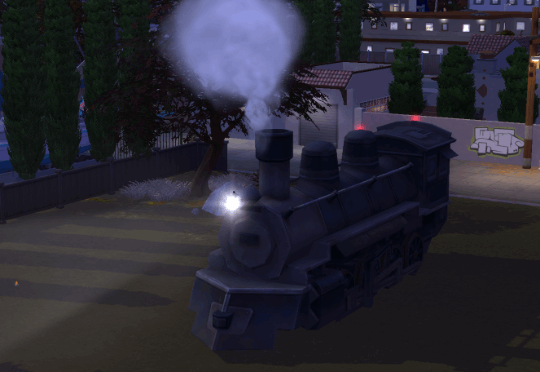
Two is by extracting the mesh and make them into a buy mode item which you can place anywhere.
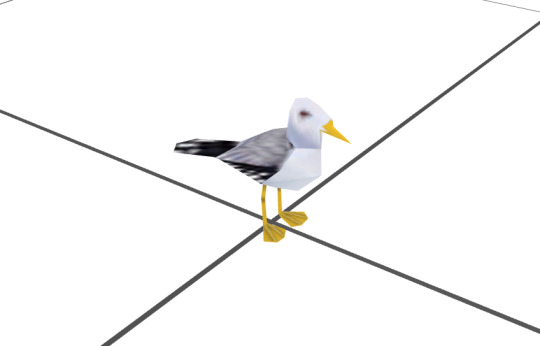
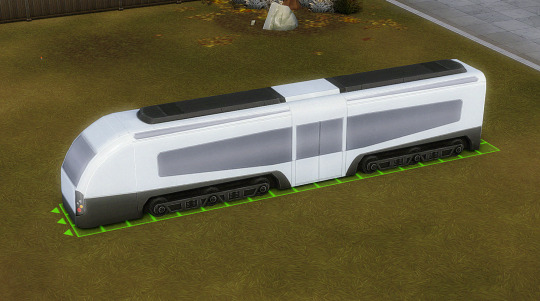
Both are static in place, and while there are some that're animated, they're located pretty far away from the spawn point that idk if it's usable XD you kind of need to do some make believe with the static objs, or figure out how to move the animated ones closer to the obj it's spawning from.
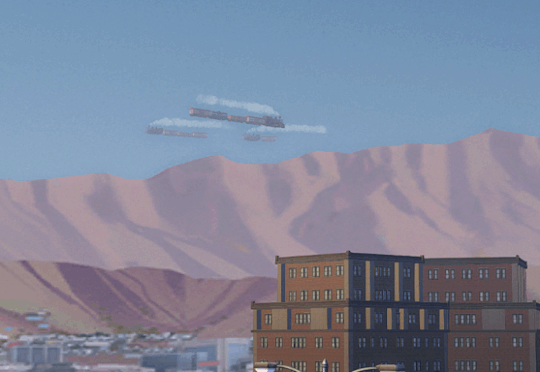
Regardless, here's a tutorial for the 2nd method since it's how I first interpreted the question haha
How to Extract VFX Meshes w/ VFX Tool
Will be going over how to find their mesh instance id w/ the VFX tool, find it in Sims 4 Studio, extract those meshes & textures, and have them buyable in-game.
Tools needed: Sims 4 Studio, VFX Tool by denton47, and Studio Effect Player mod by andrew (in-game)
All credit to denton47 for the info on how to find the mesh, I'm just relaying the info that I found there :D
VFX Tool - find mesh's instances
Install the VFX tool. Once done, select Main (1), then select Effect List (2) to get the list of all available vfx for easy viewing. This will allow you to look through the dropdown to find the VFX you need.
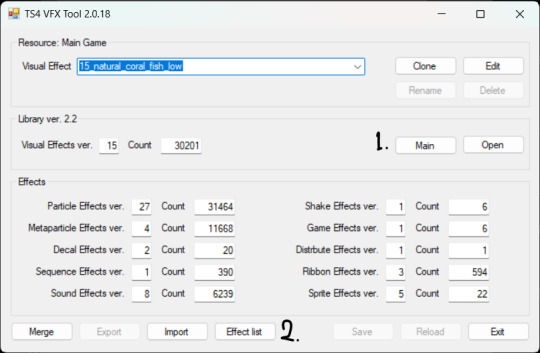
Search for the VFX you want to extract the mesh from by going over the list and use the Studio Effect Player mod to try out different keywords and see what object it's associated with (Select Effect, then paste the vfx name).



For the San Myshuno trains in particular, they are labelled as "commuter_train" and has several variations. Ones that standout/has unique variation are: commuter_train_car : on the middle w/ a middle carriage mesh spice_commuter_train_car : on the front, mesh is the same as above but w/ dirty texture uptown_commuter_train_locomotive : on the back, front/back carriage spice_commuter_train_car_locomotive : not pictured, contains 2 different meshes (front & middle/back carriage)
Once you found the VFX you need, go to Edit (1), then select Edit (2) on the first ParticleEffect. On the new window, search for the IID/instance id (3), and copy that number on notepad. Do the same for the other VFXs listed above.

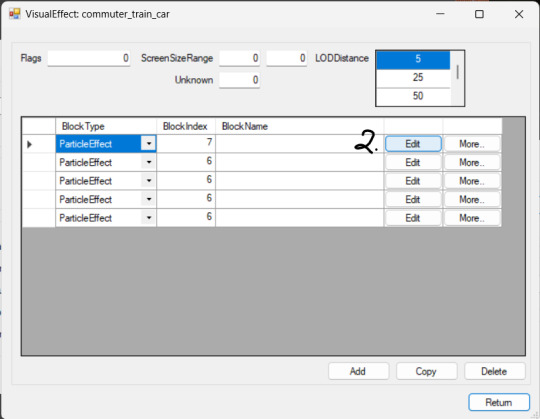
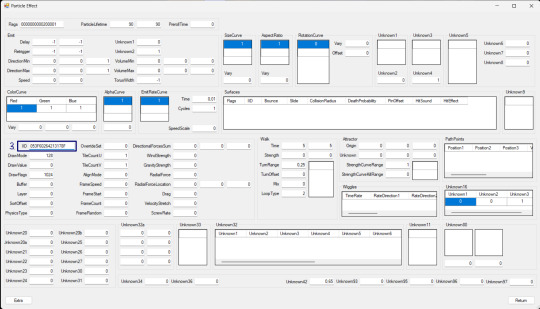
The ParticleEffect points to either a mesh or texture. The first 1 or 2 usually has the IID to the mesh while the others have IID of additional textures (e.g. headlights), which you can skip over. Here are their IID: commuter_train_car : 053F60264213178F uptown_commuter_train_locomotive : 122458A81FD85174 spice_commuter_train_car : 4F02D6E9EBE47B71 spice_commuter_train_locomotive : 973B164B6BE4933A & 562FA1E2D1E29690
S4S - find models & textures with Game File Cruiser
Open S4S > Game File Cruiser, and search for one of the IID above (will be using the commuter IID).
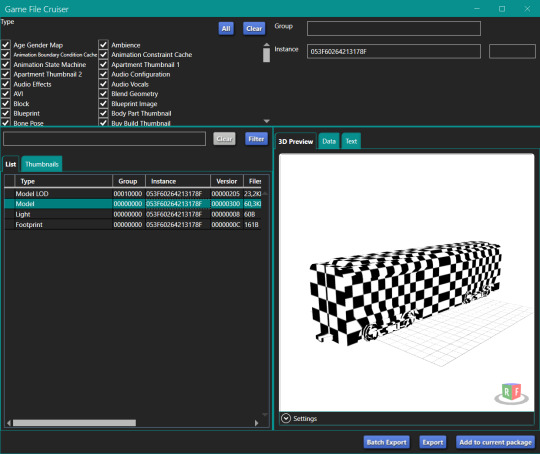
You'll notice that there's no texture. What you can do is to go to the Text tab (1) of the resource, and find the DiffuseMap IID (2), which is 6530221312A7B322.

Search for the new IID (1) in games file cruiser. This IID in particular has its own mesh and seems to have more Material information when you inspect it. So, in addition to the IIDs we found from the VFX tool, we'll also add this new mesh & resources into the package file later on.

If you plan on editing these textures, save the instance numbers of LightMapTex, NormalMap, and SpecMap onto a list, and export each of them using GFC.
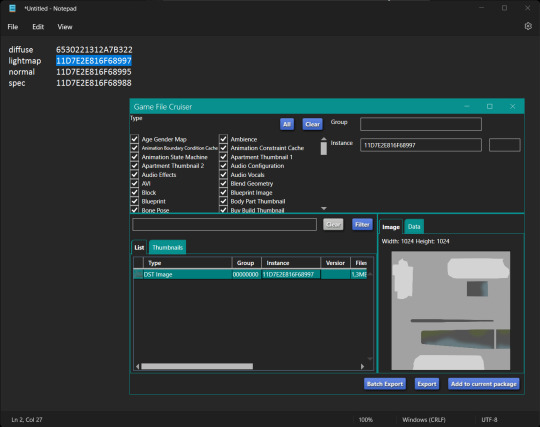
Go back and keep the main GFC window open for now.
Before you continue: take note of how many Materials / mesh groups there is on the object. Since this has 1, you'll need to clone an object with 1 mesh group too.

S4S - extracting mesh & making object override
Just for info, by editing the file to make it possible to extract the mesh, you'll be making this file into a buyable object that will also override EA's meshes & textures (if you choose to replace them), though you can add custom swatches that won't affect the EA obj.
Create a 3D Mesh item. Since this object only has one mesh group, search & clone an object with the same amount. Back in the GFC window, select all resources and add them to the current package.

With the 6530221312A7B322 IID copied, select Object Definition > Model > paste in the instance box.
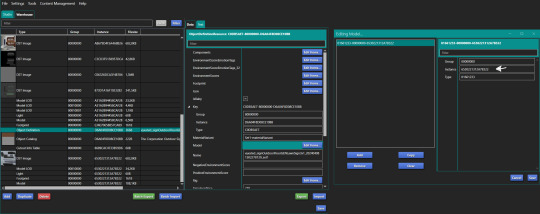
Also paste it for the Footprint resource and change the Group number to 00000000 to make sure it's linked to the right resource.

Then, select CutoutInfoTable > Entries > scroll down until you find ModelID and paste the IID you've copied.
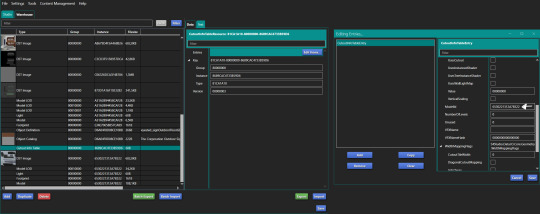
Save, reload package file, and now you can extract the mesh and textures!

Note that if you update the mesh/texture, it will also override the VFX object that goes around in San Myshuno.
Repeat the process for the other mesh variants on new package files. If you simply want to have them be buyable, getting 2 different models is fine, but if it's a texture override, then it's worth getting all the models instead.
Last note, this train object has the LargeObject shader and that seems to prevent it from lighting up at night, so you'd want to change that to Phong instead.

In-game preview:

If you want your object to have proper LODs, it'll probably be easier to clone a 3D mesh that already has that and import the train mesh you've just extracted into the cloned package file.
The train tracks are probably accessible if you look for debug/live edit objects in buy mode.
81 notes
·
View notes
Link
In this video I will show you Particles After Effects / Magic Particle / After Effects Tutorial / how to make magic particles and optical flares set on the same path in after effects tutorials.
#ParticlesAfterEffects#MagicParticle#aftereffectstutorial#aftereffects#particle#particles#particlestutorial#magicparticles#particleeffect#magic#magician#opticalflares#trapcodeparticular#opticalflaresaftereffects#opticalflare
1 note
·
View note
Video
instagram
#pixelart #animation #8bit #16bit #videogame #fire #retrostyle #oldschool #camp #woods #forest #night #stars #sky #trees #particleeffects #2d #3D #layers #motiongraphics #fullmoon #digitalpainting #digitalart #artwork #motiondesign #shadows #background #pixel #essenceofgames #games https://www.instagram.com/p/CDbbqWuK1Ai/?igshid=14hzcjx6uk4r1
#pixelart#animation#8bit#16bit#videogame#fire#retrostyle#oldschool#camp#woods#forest#night#stars#sky#trees#particleeffects#2d#3d#layers#motiongraphics#fullmoon#digitalpainting#digitalart#artwork#motiondesign#shadows#background#pixel#essenceofgames#games
2 notes
·
View notes
Video
instagram
2/5 Space Scene. A Black hole co sumes a star. #space #spacesimulation #spacesim #blackhole #star #particles #particleeffects #ue4 #unreal4 #unreal #unrealengine #gameengine
#space#blackhole#particleeffects#spacesimulation#particles#unrealengine#ue4#gameengine#unreal#star#spacesim#unreal4
4 notes
·
View notes
Photo

Advanced Particle VFX in Unity and After Effects https://www.divineworks.biz/advanced-particle-vfx-in-unity-and-after-effects/ Get up to speed with the techniques and pipelines for creating complex, high quality, AAA ready particle effects #adobeaftereffects #particleeffects #udemytutorial #graphicdesign #DivineWorks #onlinelearning https://www.instagram.com/p/B5f9wPAHOSS/?igshid=zsrtc6b75eld
0 notes
Photo

Sorc the sorcerer #characterdesign #illustration #gameart #conceptart #animation #particleeffects (at Bangalore, India) https://www.instagram.com/p/B3LIu8aHKjm/?igshid=s5yqr4sbbpre
0 notes
Photo

Small particle demo for an explosion effect used in one of our games made in #construct3 Swipe to check out the event sheet! (Kinda tiny on here though) We’ve been thinking about doing a YouTube series on some of the more advanced things you can do with construct 2 and 3. Is an advanced user video series something you guys would be interested in? 🎮 #gamedev #indiegame #indiedev #howtovideo #mechanicdemo #particleeffects #particles #demo #techdemo https://www.instagram.com/p/BtM2Y3ZnrY0/?utm_source=ig_tumblr_share&igshid=1rqk6lwps4n40
#construct3#gamedev#indiegame#indiedev#howtovideo#mechanicdemo#particleeffects#particles#demo#techdemo
0 notes
Video
tumblr
Here’s some footage of me testing the new particle effects I’ve been working on. The world is taking shape too, I show off a bit of the level design I’ve worked on as well. There’s still some polish that needs to be done visually, but it’s taking shape.
#gameplay#gamedesign#gamedev#particle#particleeffects#water#ocean#nature#game#unreal#unrealengine#ue4#unrealengine4
6 notes
·
View notes
Text
Global Particle Board Market to Witness Great Growth in Forecasted Period 2021-2028
In 2021, the Global Particle Board Market’s size was valued at USD 19.8 billion and is estimated to reach USD 23.4 billion by 2028 and is expected to be growing at a CAGR of 6.2 % throughout the forecast period. In this report, 2021 has been taken as the base year while 2020 is the historical year. The forecast year for the report is 2028 to approximate the size of the market for Particle Board.
Get | Download Free Sample Copy @ https://iconmarketresearch.com/inquiry/sample/IMR1299
Prominent Players of this market are:
· Timber Products Company
· Roseburg, Uniboard
· Dakota Premium Hardwoods
· Associate Decor Limited
· Boise Cascade
· D&R Henderson Pty Ltd
· Green Land Particle Board
· Century Plyboards India Ltd
· Krifor Industries
· Shell Laminates Pvt. Ltd
· DMK Particleboard LLP
· Kunnathan Chip Board Pvt. Lt
· Action TESA
· FA Mitchell.
Methodology
The methods used for collecting information for the report involve 4 main activities. These activities help in estimating the current size of the Particle Board market. Thorough secondary research was conducted to collect information on the Particle Board market, such as new technologies coming into the market, and components connected with this market. Then the collected information was validated with experts from the Manufacturing and Construction industry across all the value chains through primary researches. Both top-down and bottom-up approaches were used for estimating the market size.
The Report Provides Insights on The Following Pointers:
· It gives a forecast analysis of factors that are driving or restraining the development of the Particle Board market.
· The report gives a seven-year forecast value evaluated on the basis of the current market performance of the manufacturing and construction industry.
· It helps in understanding the main segments of the products and their future.
· The report gives a deep analysis of changing competition in the market which keeps you ahead of your competitors.
· The report gives the market definition of the Particle Board market along with the analysis of different factors influencing the market such as drivers, opportunities, and restraints.
#particles #particle #particlephysics #particleaccelerator #particleman #particlepeptides #particleaccerlerator #particletheory #particlesystem #particlesmasher #particlescience #particlephysicstattoo #particlephysicsstudents #particlepeople #particleobserver #particlekid #Particleio #particleeffects #particledump #particled
Thanks & Regards,
Pankaj Katkar
Digital Marketing Executive
Company: Icon Market Research
Phone: (+1) 812 506 4440
0 notes
Photo

3D Fire & Flames - Industrial VFX Generator
#3dfire#3Dflames#Unity#Unity3d#VFX#ParticleEffects#visualeffects#Industrial#DjTools#RoyaltyFree#Trance
0 notes
Photo

Magic Particle Trail ~ After Effects Tutorial http://ehelpdesk.tk/wp-content/uploads/2020/02/logo-header.png [ad_1] Download the Magic Particles res... #3dmodeling #adobe #adobeillustrator #adobexd #ae #aftereffects #autocad #blender #characteranimation #characterdesign #design #digitalpainting #drawing #effects #graphicdesign #lendonbracewell #magic #magicparticletrail #magicparticles #motiongraphics #particleeffect #particletrail #particles #photoshop #revit #stardust #template #trail #turbulentparticles #tutorial #userexperiencedesign #userinterface #vfx #visionaryfire #webdesign #wordpress
0 notes
Video
instagram
One more old audio reactive experiment. I like the colors in this one. Wrote the music probably 10 years ago. . . . . . . . . . . . . . . . . #music #musiccomposer #adobeaftereffects #aftereffects #audioreactive #motiondesigner #motiongraphics #particleeffects #trapcode #video https://www.instagram.com/p/BsoMZlEhYrf/?utm_source=ig_tumblr_share&igshid=6gfvdlgjnesj
#music#musiccomposer#adobeaftereffects#aftereffects#audioreactive#motiondesigner#motiongraphics#particleeffects#trapcode#video
0 notes
Video
instagram
"Hell is empty; all of the Devils are here 👌" #motiongraphics #emoji #emojipocalypse #emojimovie #badidea #verybadidea #clairedelune #particleeffects #aftereffects #emojiart (at Glasgow, United Kingdom)
#particleeffects#motiongraphics#aftereffects#clairedelune#emoji#emojiart#emojimovie#emojipocalypse#badidea#verybadidea
0 notes
Video
instagram
TOM and BRI looking pretty cool with sone basic particle effects 👍🤖 #botsandtherobofriends #indiedev #indiegames #madeinunity #3dmodel #gamedev #particleeffects
0 notes